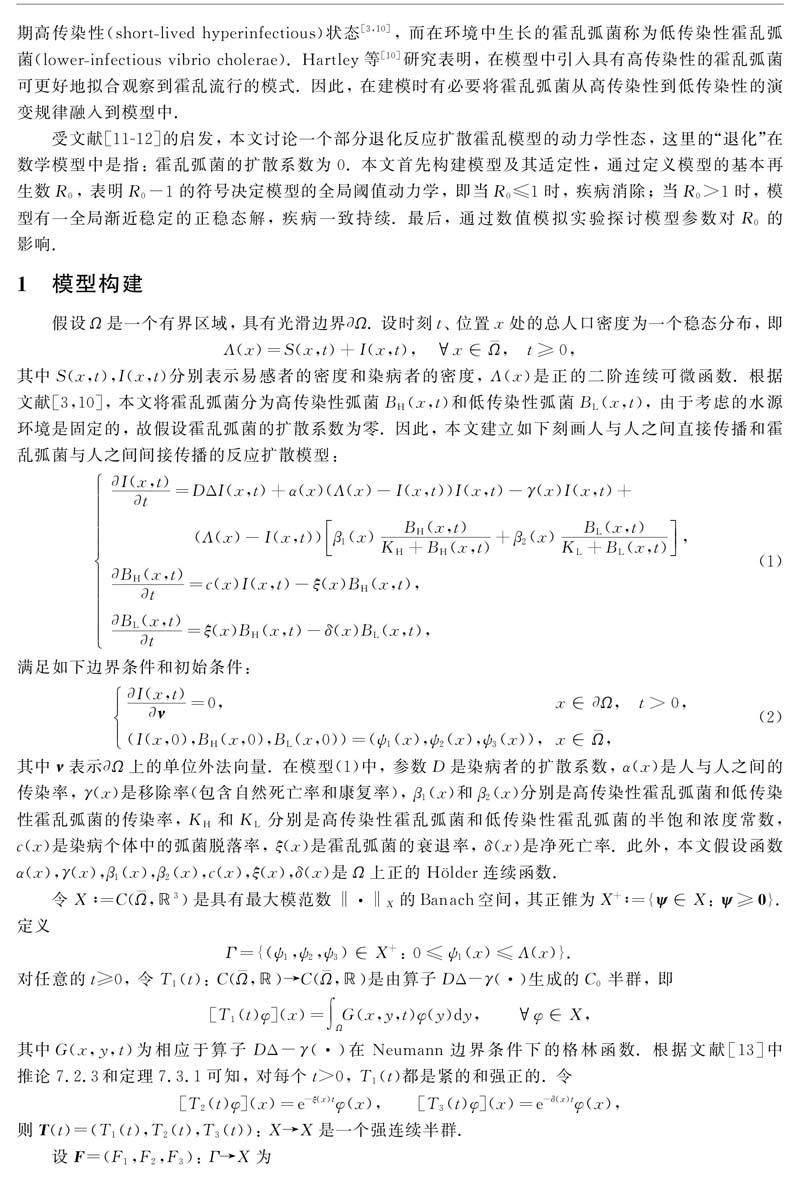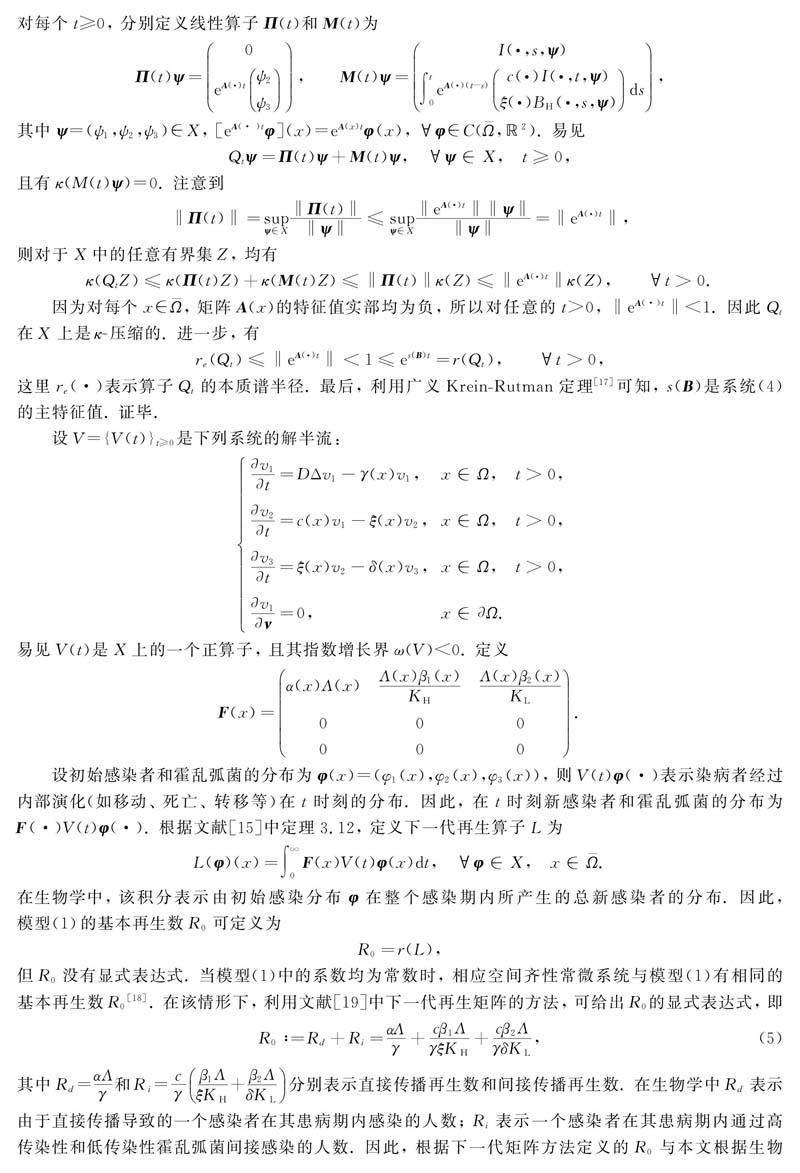一个部分退化反应扩散霍乱模型的阈值动力学
2023-04-29何杰褚慧洁
何杰 褚慧洁



摘要: 针对人的扩散、 空间异质性和处于静态水源环境中不同浓度的弧菌对霍乱传播的影响, 建立一个部分退化的反应扩散霍乱模型. 先定义模型的基本再生数R0, 表明R0-1的符号决定模型的全局阈值动力学; 然后通过数值模拟实验讨论模型关键参数对R0的影响, 结果表明适度的城市化有利于对疾病的控制.
关键词: 霍乱弧菌; 空间异质性; 基本再生数; 全局阈值动力学
中图分类号: O29文獻标志码: A文章编号: 1671-5489(2023)04-0831-09
Threshold Dynamics of a Partially DegeneratedReaction-Diffusion Cholera Model
HE Jie, CHU Huijie
(School of Mathematics and Statistics, Xidian University, Xian 710126, China)
Abstract: In order to study the effects of human to human diffusion, spatial heterogeneity and different concentrations of Vibrio in static water source environment on cholera transmission, we established a partially degenerated reaction-diffusion cholera model. Firstly, we defined the basic reproduction number R0 of the model. Secondly, the global threshold dynamics of the model was determined by the sign of R0-1. Finally, we discussed the effects of key model parameters on R0 through numerical simulation experiments. The results show that moderate urbanization is beneficial to disease control.
Keywords: vibrio cholerae; spatial heterogeneity; basic reproduction number; global threshold dynamics
霍乱是由霍乱弧菌引起的细菌性疾病, 属于急性肠道传染病, 易导致水样腹泻、 呕吐、 肌肉痉挛等症状, 大规模的霍乱疫情严重威胁人类的健康[1-5]. 霍乱是一种水媒传染病, 通常有两种传播途径: 由被霍乱弧菌污染的水或食物通过口及消化道传播, 称为间接传播; 通过人与人之间的接触传播, 称为直接传播. 基于这两种传播途径, 目前已建立了很多关于霍乱传播的模型[6-9]. 这些工作主要基于SIB(这里S表示易感者, I表示染病者, B为水中的霍乱弧菌)的仓室模型对其进行定性和定量的研究, 对理解霍乱的传播机制及其预防和控制具有积极作用.
实验表明, 存在于宿主之外的霍乱弧菌的传染性会随着时间的推移而衰减. 通常通过胃肠道在受感染的人类宿主身上新产生的弧菌可以存活数小时, 此时具有高度毒性和传染性, 称为霍乱弧菌的短期高传染性(short-lived hyperinfectious)状态[3,10], 而在环境中生长的霍乱弧菌称为低传染性霍乱弧菌(lower-infectious vibrio cholerae). Hartley等[10]研究表明, 在模型中引入具有高传染性的霍乱弧菌可更好地拟合观察到霍乱流行的模式. 因此, 在建模时有必要将霍乱弧菌从高传染性到低传染性的演变规律融入到模型中.
受文献[11-12]的启发, 本文讨论一个部分退化反应扩散霍乱模型的动力学性态, 这里的“退化”在数学模型中是指: 霍乱弧菌的扩散系数为0. 本文首先构建模型及其适定性, 通过定义模型的基本再生数R0, 表明R0-1的符号决定模型的全局阈值动力学, 即当R0≤1时, 疾病消除; 当R0>1时, 模型有一全局渐近稳定的正稳态解, 疾病一致持续. 最后, 通过数值模拟实验探讨模型参数对R0的影响.
其次, 基于文献[16]中的模拟思路, 分两种情形讨论R0与扩散系数D的关系.
情形1) 不依赖于扩散的传染率. 取β1(x)=0.23×Λ(x)×(1+sin(πx)), β2(x)=0.4×β1(x). 利用文献[23]中引理2.5和注3.2给出的R0计算策略, 绘制R0随D的变化曲线, 如图3所示. 由图3可见, R0关于D单调递减. 特别地, 当D∈(0,0.2]时, R0随D的改变急剧下降; 当D∈(0.2,1]时, R0的变化较平缓, 波动不大. 注意到感染者扩散主要是为了寻找医疗资源进行治疗. 因此当疫情开始时, 医疗资源较充足, 及时对感染者治疗将快速降低疾病的传播. 但随着疫情的延续, 感染者的快速扩散可能会导致医疗资源的挤兑, 因此扩散对R0的影响较小. 所以在霍乱传播早期, 可通过增加医疗投入对患病者给与充分的治疗, 进而降低霍乱疫情的传播.
情形2) 依赖于扩散的传染率. 取β1(x,D)=×Λ(x)×(1+sin(πx))×D/(0.01+D), 这里为基本传染率. 图4给出了R0关于扩散系数D的变化趋势, 它依赖于的大小. 当=0.01时, R0关于D单调递减(见图4(A)); 当=0.1时, R0关于D是非单调的(见图4(B)); 当=1.1, R0关于D单调递增(见图4(C)). 表明R0与扩散系数D的关系与文献[24]中单调递减的结论不同, 它依赖于模型中参数的选择. 此外, 由图4(A)~(C)可见, 对于固定的扩散率, 越大, R0越大. 因此, 当霍乱疫情暴发时, 可通过减少与不洁水源的接触、 注意个人卫生等措施降低被水源中霍乱弧菌感染的风险.
為探讨空间异质性对霍乱传播的影响, 令Λ(x)=100(1.1-σcos(2x)), 这里σ由0变化到1表示由于城市化进程, 越来越多的人离开农村来到城市[25]. 其他参数的选取除D=0.2外, 可参见式(7)和情形1). 图5为R0与σ和ξ的关系曲线. 由图5(A)可见, 随着σ的增加, R0先递减后递增, 表明适度的城市化会降低霍乱传播的风险, 但过度的城市化反而会加速疾病的传播.
最后讨论高传染性霍乱弧菌的衰退率ξ 对R0的影响. 各参数的取值参见式(7)和情形1). 由图5(B)可见, R0关于ξ单调递减, 即随着高传染性弧菌浓度的衰退, 霍乱传播的风险将逐步降低.
综上所述, 本文考虑了人及人的扩散、 不同传染性的霍乱弧菌和空间异质性对霍乱传播的影响, 通过假设水源静止, 建立了一个部分退化反应的扩散霍乱模型. 首先定义了模型的基本再生数R0, 并讨论了模型关于R0 的全局阈值动力学. 其次, 在理论上证明了R0是决定疾病消除或一致持续的阈值. 即当R0≤1时, 无病平衡点是全局渐近稳定的; 当R0>1时, 系统(1)有唯一全局渐近稳定的正稳态解. 最后, 数值实验证了理论结果, 并进一步研究了模型中关键参数对R0 的影响, 结果表明: 人口密度分布的非均匀性和城市化都会影响疾病的传播; R0关于扩散系数D是非单调性的.
参考文献
[1]MUGERO C, HOQUE A. Review of Cholera Epidemic in South Africa, with Focus on Kwazulu-Natal Province [R]. Pietermaritzburg, South Africa: KwaZulu-Natal Department of Health, 2001.
[2]CARPENTER A. Behavior in the Time of Cholera: Evidence from the 2008—2009 Cholera Outbreak in Zimbabwe [C]//International Conference on Social Computing, Behavioral-Cultural Modeling, and Prediction. Cham, Switzerland: Springer, 2014: 237-244.
[3]KAPP C. Zimbabwes Humanitarian Crisis Worsens [J]. The Lancet, 2009, 373: 447.
[4]TUITE A, TIEN J, EISENBERG M, et al. Cholera Epidemic in Haiti, 2010: Using a Transmission Model to Explain Spatial Spread of Disease and Identify Optimal Control Interventions [J]. Annals of Internal Medicine, 2011, 154(9): 593-601.
[5]ANDREWS J R, BASU S. Transmission Dynamics and Control of Cholera in Haiti: An Epidemic Model [J]. The Lancet, 2011, 377: 1248-1255.
[6]CODEO C T. Endemic and Epidemic Dynamics of Cholera: The Role of the Aquatic Reservoir [J/OL]. BMC Infectious Diseases, (2001-02-02) [2022-03-05]. https://doi.org/10.1186/1471-2334-1-1.
[7]CHIN M J, KIMBIR A R. A Mathematical Model for Cholera Epidemic [J]. IOSR Journal of the Mathematics, 2018, 14(1): 6-15.
[8]WANG X Y, WANG J. Analysis of Cholera Epidemics with Bacterial Growth and Spatial Movement [J]. Journal of Biological Dynamics, 2015, 9(Suppl 1): 233-261.
[9]WANG X Y, GAO D Z, WANG J. Influence of Human Behavior on Cholera Dynamics [J]. Mathematical Biosciences, 2015, 267: 41-52.
[10]HARTLEY D M, MORRIS J G, Jr, SMITH D L. Hyperinfectivity: A Critical Element in the Ability of V. Cholerae to Cause Epidemics? [J]. PLoS Medicine, 2006, 3(1): 63-69.
[11]WANG J L, WU X Q. Dynamics and Profiles of a Diffusive Cholera Model with Bacterial Hyperinfectivity and Distinct Dispersal Rates [J]. Journal of Dynamics and Differential Equations, 2023, 35(2): 1205-1241.
[12]WANG J L, WU W J, KUNIYA T. Analysis of a Degenerated Reaction-Diffusion Cholera Model with Spatial Heterogeneity and Stabilized Total Humans [J]. Mathematics and Computers in Simulation, 2022, 198: 151-171.
[13]SMITH H L. Monotone Dynamical Systems: An Introduction to the Theory of Competitive and Cooperative Systems [M]. Providence, RI: American Mathematical Society, 1995: 120-134.
[14]MAGAL P, XIAO X Q. Global Attractors and Steady States for Uniformly Persistent Dynamical Systems [J]. SIAM Journal on Mathematical Analysis, 2005, 37(1): 251-275.
[15]THIEME H R. Spectral Bound and Reproduction Number for Infinite-Dimensional Population Structure and Time Heterogeneity [J]. SIAM Journal on Applied Mathematics, 2009, 70(1): 188-211.
[16]PANG D F, XIAO Y N, ZHAO X Q. A Cross-Infection Model with Diffusive Environmental Bacteria [J]. Journal of Mathematical Analysis and Application, 2022, 505(2): 125637-1-125637-18.
[17]NUSSBAUM R D. Eigenvectors of Nonlinear Positive Operators and the Linear Kreǐn-Rutman Theorem [M]//Fixed Point Theory. Berlin: Springer, 1981: 309-330.
[18]WANG W D, ZHAO X Q. Basic Reproduction Numbers for Reaction-Diffusion Epidemic Models [J]. SIAM Journal on Applied Dynamical Systems, 2012, 11(4): 1652-1673.
[19]VAN DEN DRIESSCHE P, WATMOUGH J. Reproduction Numbers and Sub-threshold Endemic Equilibria for Compartmental Models of Disease Transmission [J]. Mathematical Biosciences, 2002, 180(1/2): 29-48.
[20]ZHAO X Q. Dynamical Systems in Population Biology [M]. 2nd ed. Cham: Springer, 2017: 44-62.
[21]BAI N, SONG C W, XU R. Mathematical Analysis and Application of a Cholera Transmission Model with Waning Vaccine-Induced Immunity [J]. Nonlinear Analysis: Real World Applications, 2021, 58: 103232-1-103232-16.
[22]LIAO S, WANG J. Stability Analysis and Application of a Mathematical Cholera Model [J]. Mathematical Biosciences and Engineering, 2011, 8(3): 733-752.
[23]LIANG X, ZHANG L, ZHAO X Q. Basic Reproduction Ratios for Periodic Abstract Functional Differential Equations (with Application to a Spatial Model for Lyme Disease) [J]. Journal of Dynamics and Differential Equations, 2019, 31(3): 1247-1278.
[24]ALLEN L J S, BOLKER B M, LOU Y, et al. Asymptotic Profiles of the Steady States for an SIS Epidemic Reaction-Diffusion Model [J]. Discrete and Continuous Dynamical Systems, 2008, 21(1): 1-20.
[25]LOU Y J, ZHAO X Q. A Reaction-Diffusion Malaria Model with Incubation Period in the Vector Population [J]. Journal of Mathematical Biology, 2011, 62(4): 543-568.
(責任编辑: 李 琦)
收稿日期: 2022-09-15.
第一作者简介: 何 杰(1999—), 女, 汉族, 硕士研究生, 从事生物数学与应用动力系统的研究, E-mail: hj1416500720@163.com.
基金项目: 国家自然科学基金(批准号: 11971369).